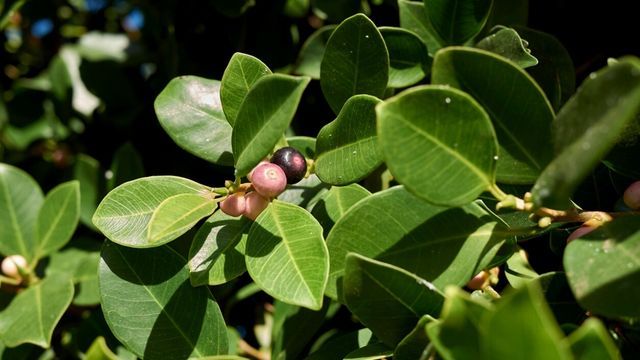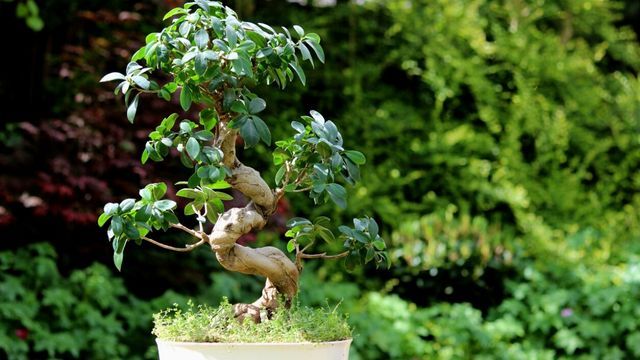Table of contents
General description of Ficus Microcarpa
- Common name: Indian Laurel, Ficus Nitida or Retusa.
- Scientific name: Ficus Microcarpa
- Family: Moraceae
- Origin: South and Southeast Asia.
- Location: indoor and outdoor
- Light: abundant (indirect)
- Temperature: between 16º C and 21º C
- Irrigation: moderate
- Fertilizer: spring and summer
Characteristics of the Ficus Microcarpa tree
The Ficus Microcarpa, known by the name of Indian Laurel, is an ornamental tree belonging to the Moraceae family and native to South and Southeast Asia.
Its name comes from the Latin Ficus-i, the classical name of the fig tree, Microcarpa, small-fruited referring to the difference in size of its figs with those of other species.
This large tree is fast growing and can reach a height of 15 to 20 m when grown under the best conditions. It is highly branched and its crown is globular and very voluminous.

The Ficus Microcarpa is an evergreen tree, that is to say, its leaves remain throughout the year. They are green, with a leathery appearance and measure about 2-6 cm. They are arranged alternately along the stems.
One of its main characteristics are its aerial roots When they touch the ground, they take root, become fat and attach to the trunk, creating a very decorative shapes.
Another curiosity of the Ficus Microcarpa and the rest of the ficus is the latex they contain. When you remove any leaf from the tree, you can clearly see that small latex substance in the form of milk that comes out. It is toxic, so whenever you are going to handle it, use gloves to avoid any type of irritation.
Does the Horse Laurel bloom?
They are dioecious (male and female in different individuals), arise between the axils of the leaves and are small and white.

Its fruits, known as sycones, are initially green in color and, as they ripen, they acquire a yellow or reddish hue. Inside, they hide a single seed.
Ficus microcarpa ginseng
Ficus is probably one of the most widespread genera in the world of bonsai, especially among the apprentices of this millenary art, due to the simplicity of its care, its resistance to climate, its rapid growth and the flexibility of its trunk.
Within the genre, the Ficus microcarpa is one of the most commonly used trees to create them and, from it, the one known as Ficus ginseng, Ficus bonsai or Ficus retusa has been obtained.
This variety is striking for the volume of its roots, which have undergone a process in which they have been intertwined, making the aerial part of the roots larger. These roots have been used in a process in which they have been intertwined. aerial roots act as pillars of support Its bark is usually smooth and gray in color.
 Initial bonsai care (and mistakes to avoid)
Initial bonsai care (and mistakes to avoid)
Ficus ginseng should not be confused with true Korean ginseng ( Panax Ginseng ) which is considered, in traditional Chinese medicine, as a plant capable of curing all ills. Nor should it be confused with the Ficus microcarpa Tiger bark In case you are interested, in this video Kaeru explains how to tell them apart.
Care Ficus microcarpa or Indian Laurel
Light and location
Is it indoor or outdoor? This ficus can be grown both in the garden and in the home, but as it is a tree, it is always more advisable to grow it outdoors if the conditions are right.
Outdoors, it will develop perfectly in subtropical or temperate climates around 16º C. It does not support well the cold so, in case you live in a cold area, it will be more appropriate to bring it indoors.
Indoors, place it near a window and turn the pot regularly so that all parts of the plant grow equally.
Irrigation
The Ficus microcarpa you need moderate irrigation avoiding waterlogging at all costs.

To maintain adequate humidity, you can place a water source nearby or spray it several times a day. It is also recommended to keep it away from any heat source such as heating or air conditioning.
Soil and compost
Thanks to the resistance of its roots, it grows in almost any type of soil. To promote its growth and development, it appreciates to be fertilization from spring to autumn.
Frequently Asked Questions about Ficus microcarpa
Is Ficus microcarpa an invasive species?
It is not currently considered invasive in Spain but it is in other parts of the world such as Hawaii, Florida and Bermuda.
What is the main problem when growing this ficus?

The main problem with these trees is due to the fact that their root system is so strong which ends up lifting everything in its path in the garden: pavement, nearby buildings, pipes... Therefore, before planting any variety in the garden, it is important to analyze whether there is enough space and distance.

